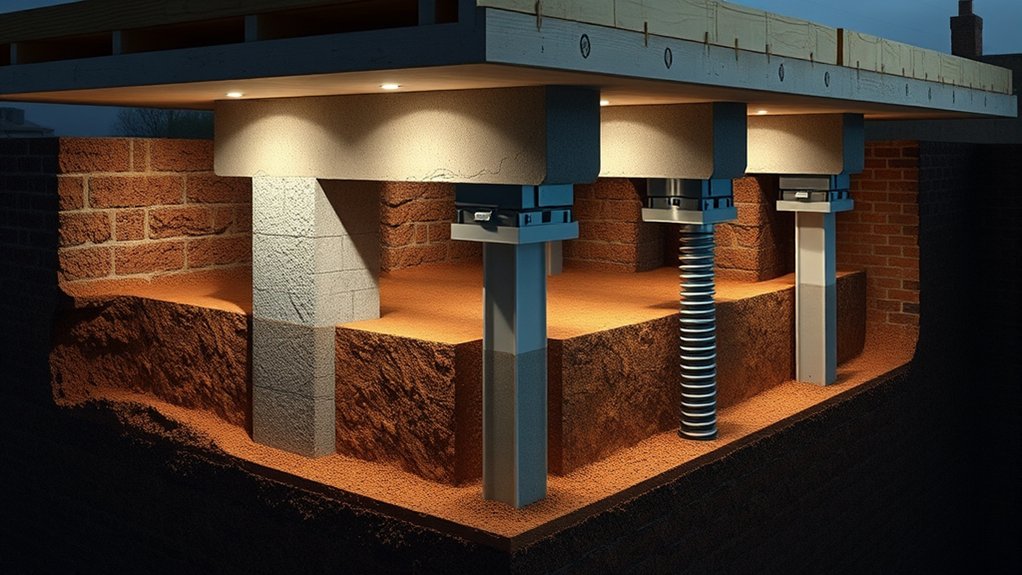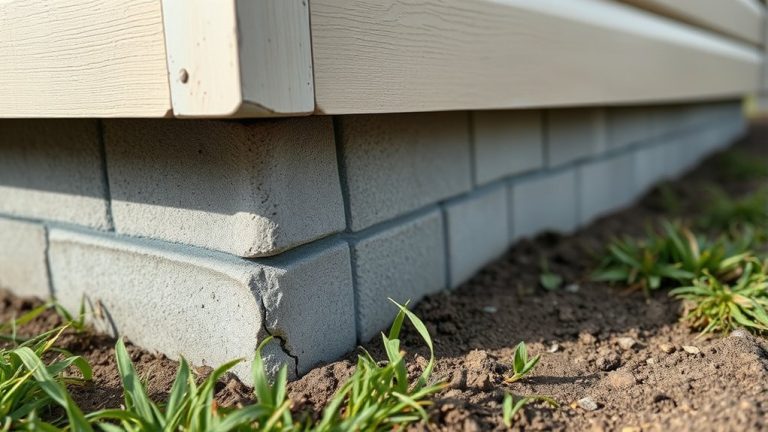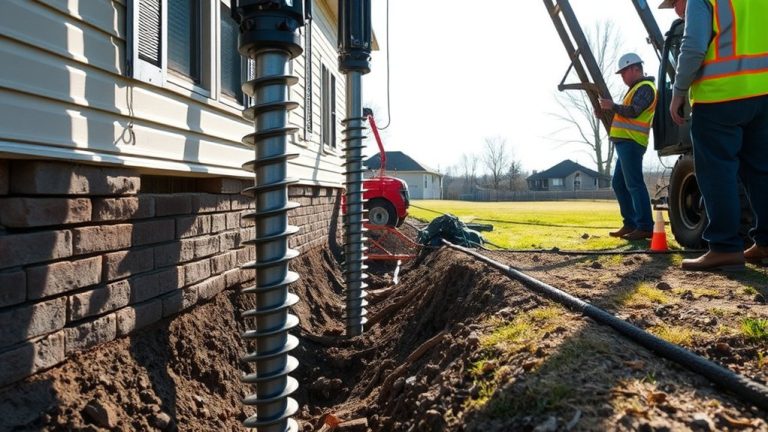When your home's foundation starts showing signs of trouble, you'll want to understand foundation piers. These critical support structures can save you from costly structural damage and provide stability in challenging soil conditions. Whether you're battling shifting ground, dealing with water pressure, or seeking long-term structural protection, foundation piers offer a strategic solution. Curious about how these engineering marvels can safeguard your property? Let's investigate the world of foundation support.
Key Takeaways
- Foundation piers are specialized structural supports designed to stabilize buildings by addressing challenging terrain and soil conditions.
- Multiple pier types exist, including concrete, steel, helical, driven, and timber piers, each offering unique advantages for different environmental challenges.
- These structural solutions effectively distribute building weight, counteract soil movement, and prevent long-term foundation settlement and potential structural damage.
- Pier systems can be engineered to withstand diverse environmental pressures such as hydrostatic pressure, soil expansion, and extreme weather conditions.
- Installation techniques vary by pier type, with options ranging from hydraulic pile driving to minimally invasive methods that reduce property disruption.
Concrete Foundation Piers: Strength and Durability
Concrete foundation piers stand as the unsung heroes of structural stability, offering homeowners a sturdy solution for supporting buildings in challenging terrain. They're designed with innovative concrete mixes that augment strength and resilience, giving you peace of mind about your property's foundation.
A reinforced foundation using concrete piers can withstand significant environmental pressures, from soil shifting to extreme weather conditions. You'll appreciate how these steadfast supports distribute weight evenly, preventing structural damage and potential long-term issues. They're not just strong—they're your home's silent guardians. Foundation wall stabilization methods like concrete piers can effectively counteract common issues such as hydrostatic pressure and soil expansion that lead to structural weakening.
Steel Pier Systems: Heavy-Load Support
Steel pier systems represent a sturdy solution for homeowners facing significant foundation challenges, particularly in areas with unstable soil conditions. You'll appreciate their corrosion resistance and impressive load capacity, which make them an ideal choice for supporting heavy structures.
These systems can stabilize your home's foundation by transferring weight through weak soil layers to more solid ground beneath. Steel piers offer long-lasting performance and can be installed quickly with minimal landscape alteration. They're engineered to withstand extreme environmental pressures, providing you with a reliable foundation repair method that safeguards your home's structural integrity and gives you peace of mind. Foundation repair technicians in Syracuse, NY specialize in these advanced steel pier installations to address local structural challenges.
Helical Piers: Versatile Ground Stabilization
Because ground stability can make or break your home's foundation, helical piers offer an innovative solution for challenging terrain. These specialized supports adjust to various soil conditions, ensuring your property remains secure and level.
Key benefits include:
- Superior load capacity for heavy structures
- Minimal site disruption during installation
- Quick and efficient foundation repair
- Versatile application across different environments
Helical piers' screw-like design allows them to penetrate unstable ground, providing reliable support where traditional methods might fail. They're particularly effective in areas with expansive clay, sandy soils, or high water tables, giving homeowners peace of mind about their foundation's long-term stability.
Driven Piers: Deep Foundation Solutions
While helical piers offer innovative ground stabilization, driven piers represent another powerful foundation support method for homeowners facing structural challenges.
You'll find these piers installed using hydraulic pile driving techniques that push steel or concrete columns deep into the ground. They're particularly effective in areas with unstable soil conditions, providing sturdy structural support for buildings experiencing settlement issues.
Jetted pier installation can help you quickly address foundation problems, minimizing interference to your property. By transferring building loads to more stable soil layers, driven piers offer a trustworthy solution for maintaining your home's structural integrity.
Timber Piers: Traditional Support Techniques
Since ancient civilizations first developed engineering foundations, timber piers have served as a reliable and time-tested support technique for structures built on challenging terrain. They offer unique advantages for creating raised footings and ensuring effective load distribution across uneven ground.
Naturally resistant to moisture and decay
Cost-effective compared to modern alternatives
Lightweight and easy to install
Accommodating to various soil conditions
Timber piers provide builders with flexibility in design, allowing you to construct sturdy foundations that withstand environmental challenges. By understanding their traditional techniques, you'll appreciate how these classic support systems continue to offer practical solutions for challenging construction environments.
Comparing Installation Methods and Costs
When evaluating timber pier installation, homeowners and contractors must carefully consider both cost-effectiveness and long-term structural performance.
Your installation process details will vary depending on soil conditions, property needs, and budget constraints. Different techniques like driven piers, drilled piers, and helical piers offer unique advantages in comparative cost analysis.
While driven piers might be cheaper upfront, they can cause more ground interference. Drilled piers provide better stability but require more labor. Helical piers offer versatility and minimal site disturbance, though they're typically more costly.
Your specific project's requirements will finally determine the most suitable and cost-effective approach.
Factors Affecting Pier Selection
Several critical factors influence pier selection, making the decision far more complex than simply choosing the most affordable option. When evaluating foundation piers, you'll want to contemplate multiple critical elements that impact your specific project's success.
Your pier selection depends on:
- Soil conditions and ground stability
- Groundwater levels and drainage patterns
- Property's structural requirements
- Budget and long-term maintenance costs
Comprehending these factors helps you make an informed decision that guarantees your foundation's durability, stability, and performance. You'll need to carefully assess each element to select the most suitable pier type for your unique situation.
Maintenance and Long-Term Performance
After carefully evaluating the right pier for your foundation, understanding its maintenance requirements becomes equally important for long-term structural integrity. Regular inspection schedules will help you catch potential issues before they escalate, saving you money and preventing significant structural damage.
You'll want to monitor your foundation piers annually, checking for signs of shifting, cracking, or uneven settling. Professional assessments can identify subtle changes that might compromise your home's stability. By staying proactive and attentive, you're not just maintaining a foundation—you're protecting your most precious investment and ensuring your property remains secure and sound.
Frequently Asked Questions
Can Foundation Piers Be Installed on Sloped or Uneven Terrain?
You'll find foundation piers can absolutely be installed on sloped terrain, tailoring to uneven site conditions through specialized techniques that guarantee structural stability and level support for your building.
How Long Do Different Types of Foundation Piers Typically Last?
You'll find pier durability varies by material, with steel and concrete lasting 50-100 years if you maintain them properly and protect against environmental stressors like moisture and soil conditions.
Do Foundation Piers Increase or Decrease My Property's Overall Value?
Foundation piers can increase your property's value by providing improved home stability, giving potential buyers confidence in the structural integrity and long-term durability of your home's foundation.
Are There Environmental Considerations When Choosing a Specific Pier Type?
You'll want to evaluate soil erosion mitigation and execute an environmental impact assessment when selecting pier types, ensuring minimal landscape alteration and preserving local ecological balance.
Can Foundation Piers Be Used for Both New and Existing Structures?
You'll find foundation piers suitable for new and existing structures, depending on pier depth requirements and installation methods that'll restore structural integrity with minimal interference to your property.


